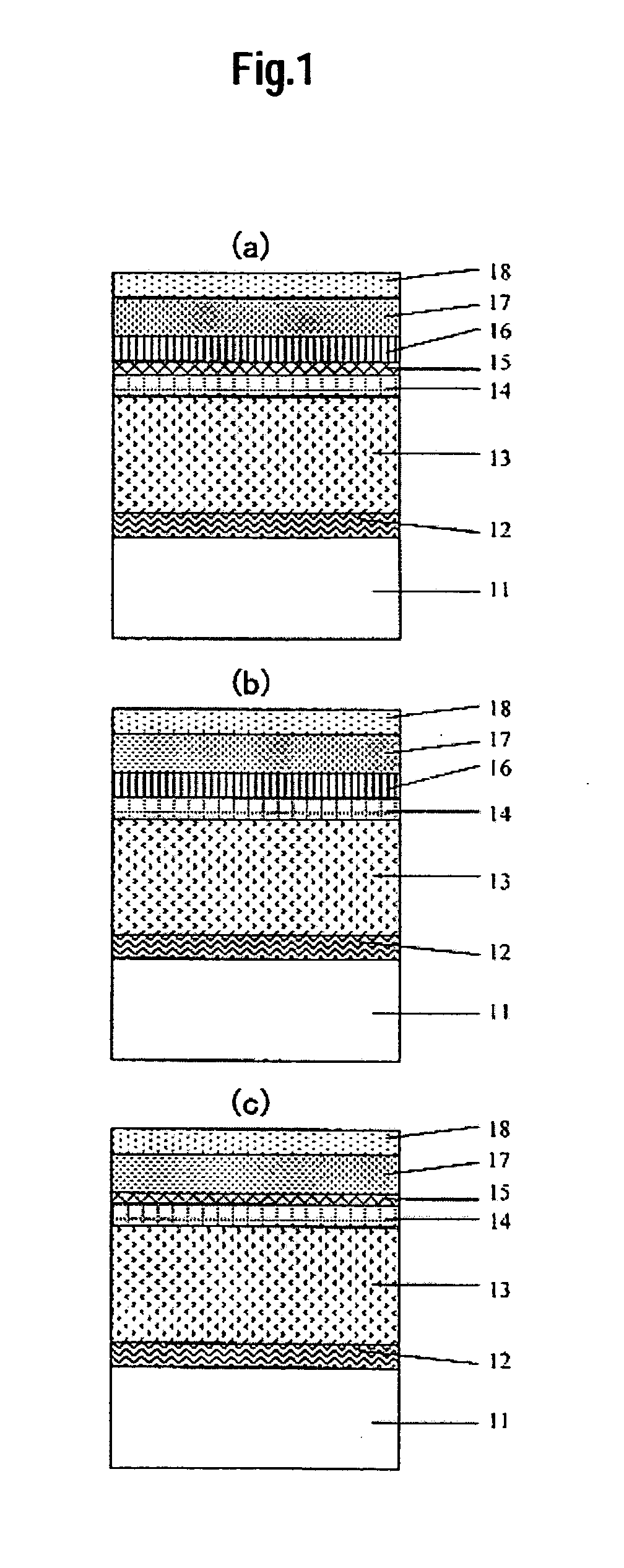Perpendicular magnetic recording media and magnetic storage apparatus using the same
- Summary
- Abstract
- Description
- Claims
- Application Information
AI Technical Summary
Benefits of technology
Problems solved by technology
Method used
Image
Examples
first embodiment
[0052] A perpendicular magnetic recording medium in accordance with the first embodiment is produced using sputtering equipment (C-3010) manufactured by Anelva Corp. The sputtering equipment comprises ten process chambers and one substrate loading / unloading chamber. The chambers are mutually independently pumped. After all the process chambers are pumped down to a vacuum of 1×10−5 Pa or less, a carrier on which a substrate is placed is moved to each of the process chambers so that the substrate will successively undergo processes. A rotary magnet type magnetron sputter cathode is incorporated in a sputtering process chamber. A metal and carbon are produced through DC sputtering, and an oxide film is produced through RF sputtering. Moreover, special cathodes called rotating cathodes are incorporated in one sputtering process chamber. The three rotating cathodes whose power can be controlled mutually independently are revolved in front of a substrate, whereby a multilayer film or an a...
second embodiment
[0072] A perpendicular magnetic recording medium in accordance with the second embodiment is produced to have the same layered structure as the one of the first embodiment under the same conditions for a process using the same sputtering equipment. However, as the compositions of intermediate layers, a first intermediate layer 14 of about 4 nm thick is composed of Ti, a second intermediate layer 15 whose average thickness is about 0.8 nm is composed of Cu, and a third intermediate layer 16 whose thickness is varied within a range from about 3 nm to 15 nm is composed of Ru.
[0073] As samples to be compared with the second embodiment, three kinds of media whose internal layers have different compositions were produced. A medium having the first intermediate layer 14 of about 4 nm thick composed of Ti, having the second intermediate layer 15, of which the average thickness was about 0.8 nm, composed of Cu, and being devoid of the third intermediate layer 16 composed of Ru was produced ...
third embodiment
[0082] A perpendicular magnetic recording medium in accordance with the third embodiment is produced to have the same layered structure as the first embodiment under the same conditions for a process using the same sputtering equipment. As for the compositions of intermediate layers, a first intermediate layer 14 of about 4 nm thick that is composed of Ti, a second intermediate layer 15 having an average thickness of about 1 nm, and a third intermediate layer of about 10 nm thick that is composed of Ru are formed successively. The second intermediate layer 15 is composed of any of Al, Ag, Au, Cu, Ni, Pd, Au-50 at. % Cu, Cu-15 at. % Al, Cu-20 at. % Ni, Ag-30 at. % Pd, Cu-5 at. % Ti, Cu-3 at. % Ta, Cu-3 at. % B, Ag-40 at. % Cu, and Cu-45 at. % Pd. As samples to be compared with the third embodiment, media whose intermediate layers have compositions described below were produced. A medium having the same layered structure as the third embodiment and having the second intermediate layer...
PUM
 Login to View More
Login to View More Abstract
Description
Claims
Application Information
 Login to View More
Login to View More - R&D
- Intellectual Property
- Life Sciences
- Materials
- Tech Scout
- Unparalleled Data Quality
- Higher Quality Content
- 60% Fewer Hallucinations
Browse by: Latest US Patents, China's latest patents, Technical Efficacy Thesaurus, Application Domain, Technology Topic, Popular Technical Reports.
© 2025 PatSnap. All rights reserved.Legal|Privacy policy|Modern Slavery Act Transparency Statement|Sitemap|About US| Contact US: help@patsnap.com



